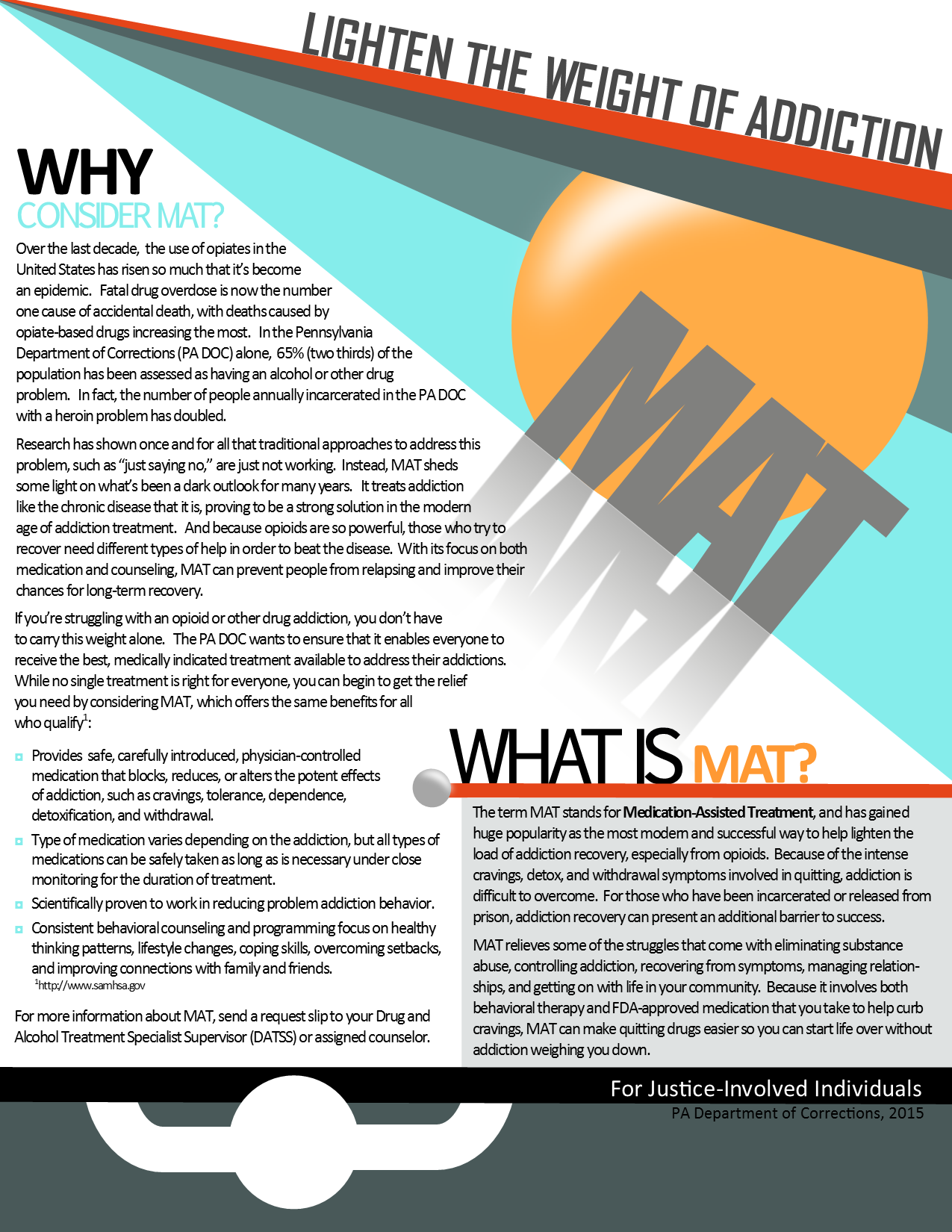Enhance Treatment and Recovery Support During Incarceration
Introductory Paragraph
A significant number of inmates suffer from substance use disorder, a psychological disorder, or a combination of the two. When proper treatment is made during incarceration there is a decrease in inmate misconduct. When treatment is followed through to post-release, there is documented lower risk for relapse and recidivism (the likelihood that a convicted criminal will reoffend).
Key Information
Prison treatment programs have been successful, and there are clear benefits to them. Well-designed prison treatment programs reduce relapse, criminality, inmate misconduct and recidivism. They also increase levels of education, mend relationships, boost employment opportunities upon release and improve overall health. Cost-benefit analysis indicates that residential prison treatment is cost-effective if prisoners continue treatment after their release. There are immediate and long-term fiscal benefits. In a direct and immediate cost comparison, the cost of treatment pales in comparison to the cost of incarceration. In a longer-term vantage point, when prisoners overcome drug use, it reduces the economic burden of recidivism. [1]
In general, the criminal justice system supports treatment during incarceration by offering inmates with substance use problems a mix of psychotherapy sessions, religious ministry meetings, and 12-step programs, such as Alcoholics Anonymous. [2] The federal prison system utilizes four primary types of programs to assist inmates in overcoming a substance use disorder:
- The Residential Drug Abuse Program (RDAP) is the most intensive program that the Federal Bureau of Prisons will provide and is normally nine months in length. Inmates in this program live in their own separate community from the rest of the population. Inmates take part in daily half-day programming and a half-day of work, school, or vocational activities. Research has shown that inmates that take part in RDAP are significantly less likely to recidivate and relapse to drug use compared to those inmates who do not take part in RDAP. [3]
- Nonresidential Drug Abuse Treatment. This involves a 12-week cognitive behavioral therapy (CBT) program that is organized in group sessions that address criminal lifestyles while increasing skills in the areas of rational thinking, communication, and institution-to-community adjustment. Inmates that are enrolled in this program normally have short sentences, do not meet the Residential Drug Abuse Program, are waiting to be enrolled in RDAP, are in transition back into the community or have a positive urinalysis test [4]
- Drug Abuse Education entails a series of classes that educate inmates on substance use disorder and the effects it has on your body and mind. [5]
- Community Treatment Services (CTS) provides continued care to inmates who have been released and put into Residential Reentry Centers or on Home Confinement. Evidence shows that the period after being released is the most vulnerable time for inmates to relapse back to drug use or criminal activity. So, continued treatment after release is vital to the success of the offender completing their treatment. [6]
Relevant Research
- This article documents the benefits of treatment for the incarcerated in terms of both increased recovery rates and decreased recidivism. [7]
- GAO Report on Overcrowding of Jails and Prisons. One of the major barriers to treatment and recovery support during incarceration is the availability of effective treatment. Overcrowding is a leading factor as to why inmates with drug dependency problems are not enrolled in these programs. This report indicates that over 50,000 inmates were on waiting lists to enter drug treatment programs. In addition to overcrowding, staff shortages and limited resources are part of the enrollment issues in drug treatment programs. [8]
- SAMHSA has published Treatment Improvement Protocol (TIP) titled, "Substance Abuse Treatment: For Adults in the Criminal Justice System." In addressing the need for trauma-informed care, the report distinguishes between historic trauma as root cause of criminality and trauma associated with incarceration. The panel that made the report, reached consensus on the recommendation that in-prison treatment address both the trauma of the incarceration itself and the prison culture that conflicts with treatment goals. Since prisons can be violent, harsh, and psychologically damaging, incarcerated people live in an environment that is both depersonalizing and dehumanizing. When added to the social stigma associated with incarceration, this may result in a sense of hopelessness and powerlessness, as well as deeply internalized shame and guilt -- highlighting the need to concurrently treat for both substance use and mental health. [9]
Impactful Federal, State, and Local Policies
Several states are working to address the Opioid epidemic and embracing new strategies such as utilizing Medicaid 1115 Demonstration Waivers which increases provision of Medication Assisted Therapy (MAT) to individuals in the criminal justice system. [10]
New York State passed legislation in 2015 to allow individuals Medication Assisted Therapy [11] in diversion programs The legislation ensures those participating would not face charges due to MAT medications/drug screens. [12]
Tools & Resources
Residential Substance Abuse Training RSAT training and technical assistance tool. This provides training for correctional professionals.[13]
Reentry resources for individuals, providers, communities and States [14]
Building an Offender Reentry Program: Guide for Law Enforcement [15]
Medication Assisted Treatment in Criminal Justice Systems: Guidance to the States [16]
Criminal Conduct & Substance Abuse Treatment: Strategies for Self-Improvement and Change Pathways to Responsible Living- Workbook for participants [17]
Principles of Drug Abuse Treatment for criminal justice populations [18]
Promising Practices
Pennsylvania Department of Corrections Medication Assisted Treatment – includes a 2019 Pilot Program [19]
Sources
- ↑ https://doi.org/10.1007/s11920-013-0414-z
- ↑ https://www.alec.org/article/drug-treatment-programs-of-the-federal-bureau-of-prisons-exist-but-need-more-availability/
- ↑ https://www.alec.org/article/drug-treatment-programs-of-the-federal-bureau-of-prisons-exist-but-need-more-availability/
- ↑ https://www.alec.org/article/drug-treatment-programs-of-the-federal-bureau-of-prisons-exist-but-need-more-availability/
- ↑ https://www.alec.org/article/drug-treatment-programs-of-the-federal-bureau-of-prisons-exist-but-need-more-availability/
- ↑ https://www.alec.org/article/drug-treatment-programs-of-the-federal-bureau-of-prisons-exist-but-need-more-availability/
- ↑ https://www.ncbi.nlm.nih.gov/pmc/articles/PMC2681083/
- ↑ https://www.alec.org/article/drug-treatment-programs-of-the-federal-bureau-of-prisons-exist-but-need-more-availability/
- ↑ https://www.ncbi.nlm.nih.gov/books/NBK572935/
- ↑ https://store.samhsa.gov/sites/default/files/d7/priv/medicaidfinancingmatreport_0.pdf
- ↑ https://www.nysenate.gov/legislation/bills/2019/S2161
- ↑ https://www.lac.org/assets/files/Medication-Assisted-Treatment-in-Drug-Courts-Recommended-Strategies.pdf
- ↑ https://nicic.gov/training
- ↑ https://www.samhsa.gov/sites/default/files/topics/criminal_juvenile_justice/reentry-resources-for-consumers-providers-communities-states.pdf
- ↑ https://bja.ojp.gov/sites/g/files/xyckuh186/files/Publications/Reentry_LE.pdf
- ↑ https://store.samhsa.gov/sites/default/files/d7/priv/pep19-matbriefcjs_0.pdf
- ↑ https://www.ojp.gov/ncjrs/virtual-library/abstracts/criminal-conduct-substance-abuse-treatment-strategies-self
- ↑ https://www.txwp.uscourts.gov/wp-content/uploads/2017/05/Recommended-Reading-Drug-Abuse-Treatment-for-Criminal-Justice-Populations.pdf
- ↑
